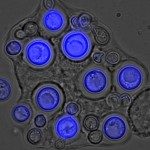Link to Pubmed [PMID] – 20100136
Med. Mycol. 2010 Sep;48(6):785-91
Clinical manifestations, treatment, and outcomes of cutaneous cryptococcosis in solid organ transplant (SOT) recipients are not fully defined. In a prospective cohort comprising 146 SOT recipients with cryptococcosis, we describe the presentation, antifungal therapy, and outcome of cutaneous cryptococcal disease. Cutaneous cryptococcosis was documented in 26/146 (17.8%) of the patients and manifested as nodular/mass (34.8%), maculopapule (30.4%), ulcer/pustule/abscess (30.4%), and cellulitis (30.4%) with 65.2% of the skin lesions occurred in the lower extremities. Localized disease developed in 30.8% (8/26), and disseminated disease in 69.2% (18/26) with involvement of the central nervous system (88.9%, 16/18), lung (33.3%, 6/18), or fungemia (55.6%, 10/18). Fluconazole (37.5%) was employed most often for localized and lipid formulations of amphotericin B (61.1%) for disseminated disease. Overall mortality at 90 days was 15.4% (4/26) with 16.7% in disseminated and 12.5% in localized disease (P = 0.78). SOT recipients who died were more likely to have renal failure (75.0% vs. 13.6%, P = 0.028), longer time to onset of disease after transplantation (87.5 vs. 22.6 months, P = 0.023), and abnormal mental status (75% vs. 13.6%, P = 0.028) than those who survived. Cutaneous cryptococcosis represents disseminated disease in most SOT recipients and preferentially involves the extremities. Outcomes with appropriate management were comparable between SOT recipients with localized and disseminated cryptococcosis.
